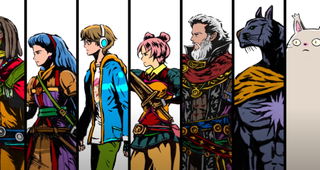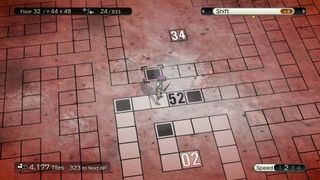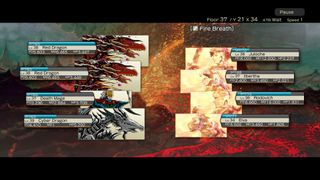Dungeon Encounters finds depth in stripping the JRPG down to its essentials
Clever combat and exploration hide behind the barebones presentation.

I really should have mounted this expedition a little earlier, but here I am with Rwenzo, rescuing my incapacitated heroes scattered across a dozen floors of this dungeon and delivering them back to town on the first floor.
The urgency is real because I’ve realised I’ve been risking a permanent game over with every battle. If my party is wiped by the ever-increasing threats I’m facing, I can only continue the game if I have conscious characters on the first floor to start a new party with. So I equipped Rwenzo with my best gear, left my other three party slots open to fill with rescued characters, and heroically departed with her on a quest of my own making, a desperate mission that emerged naturally from a game that initially seemed absurdly abstract and simplistic.
Dungeon Encounters has no storyline other than the high level scenario: a weird monster-filled labyrinth has appeared near a town. It has no lead characters, instead a roster of 24 names, each with a picture and a sliver of biography buried in a sub-menu. It has no naturalistic world to explore: the labyrinth is just a series of floors drawn as grids against a simple background (at times it resembles a crossword puzzle). It has no roaming monsters to observe and avoid, just locations on the grid marked with black hexadecimal codes and static images of them during the turn-based battles. It has no visible shops, shrines or stairs, just white hexadecimal codes marking their locations and menus to browse. And your objective? Simply to explore each of the game’s 99 floors.
So yes, Dungeon Encounters is barebones. And yet… a soundtrack of whistling wind and drips conjures an atmosphere of dank neglect in the first nine floors of the dungeon, while the birdsong and the lush grassy background of the next 10 floors reflect your growing confidence and awareness of the pleasure in walking every square in every floor (gotta walk ‘em all).
And also, of course, the pleasure of discovering what lies beneath its simple ruleset. My quest to rescue my characters is the result of just three rules:
- Whether dead, petrified, or alive, characters remain in the exact spot where you left them
- A new party can only be assembled from characters who are alive and located on floor 1
- The game ends if your active party is wiped and a new one can’t be raised
And thus a new facet of the game popped into existence.
ASCII dungeon-delvers like Rogue, Angband, and Brogue have long-proven that rich choice and consequence can emerge from the most abstract and mechanical setups. In particular, Dungeon Encounters resembles Angband in its looping play as you go deep and then return to the surface to restock and reequip, though it’s a lot less detailed. In that sense, Dungeon Encounters is a lot more like the formative 1980s RPGs, particularly Wizardry, which focused on exploration of labyrinths and directly inspired the entire JRPG genre.
The biggest gaming news, reviews and hardware deals
Keep up to date with the most important stories and the best deals, as picked by the PC Gamer team.

After all, Dungeon Encounters is very much a JRPG. It was directed by Hiroyuki Ito, one of the mainstay designers of the Final Fantasy series. He was director of the magisterial Final Fantasy Tactics, and architected Final Fantasy 12’s revolutionary gambit system, in which you write AI rules for your characters to use in battle. He was also the designer of Final Fantasy’s classic Active Time Battle system, first introduced in Final Fantasy 4, which uses gauges to manage character turns and takes a central role in Dungeon Encounters’ battles.
These battles are Dungeon Encounters’ beating heart, and like the rest of the game, they’re massively abstracted and simplified. There’s no flashy Final Fantasy elemental magic or summons. Spells neither have charges nor require mana, so when you select them, they feel no different to a swipe of a sword, and every attack merely either does set damage or a random amount to an upper limit.
There’s also no weapon degradation, no potions or buffs. Incredibly, there are no character stats at all, other than level, health and proficiency points, which you earn by exploring floors and govern what gear you can equip.
Yet this minimalist reengineering of the classic JRPG battle system has you examine minutely the subtle strategies that emerge. In the first battles you explore the way the ATB gauges ask you to make decisions over which enemy to target: hit and kill this enemy before its gauge fills, preventing an extra attack, or take out that enemy first because it’s the most dangerous?
Then you find yourself exploring the interplay between the ATB system and Dungeon Explorers’ defence design, which gives each character and monster two forms of defence, one against physical damage and the other against magical.
Granted by armour, these defences are numerical soaks that prevent damage against HP until fully exhausted, and they fully recharge between battles. From these two rules, a nuanced situations emerge. Even a single point remaining in a defence will fully block permanent damage, enabling skin-of-teeth escapes from death and survival against all odds. And the way they recharge means your party can keep exploring for much longer than in many dungeon crawlers, because you’ll generally return to full effectiveness after every battle. At least until you step on a battle number that's far higher than the rest on the floor, and realize there are some enemies out there waiting to crush you. The difference between a 44 and a 94 is life and death.

As you obtain new weapons and armour, your party naturally begins to take a shape. The game is careful to limit access to powerful spells like Petrify, which turns a monster into stone over the course of five in-game seconds, or a sword which attacks every monster, or a powerful bow, which can hit flying monsters, so when you give one to a character, they’re suddenly made special.
Tactics switch and reform as you meet new monsters. You learn that flying monsters are immune to melee physical attacks; that sharks have no magical defence; that some armour grants speed bonuses which fill characters’ ATB gauges faster but at the expense of their defence. Battles are fast and reward efficiency, and since you enter each battle on a consistent footing you rarely feel that a difficult battle sets you on a spiralling path to doom. Executing commands can feel like a dance as you watch the gauges of enemies and allies and plan your assault.
There are many other little features: you can equip party-wide abilities which resurrect and heal your characters; allow you to ascend and descend floors if there’s a grid location at your coordinates, and a UI-changing skill which zooms the view of the grid out so you can see further. There are logs, lists of the most recently discovered shops and special destinations like the Gorgon Altar, which can heal petrified characters if you input their coordinates. And there are fun and weird things, too—maths and map riddles that point to coordinates to search for treasure.
But each feature is designed down to its essentials, wringing as much utility out of it as possible. By returning to their roots in Wizardry and Ultima, Dungeon Encounters discards a great deal of the cruft that’s built up around Japanese RPGs, and finds new purpose. A dungeon, a party, weapons, armour and monsters, and the promise that you can always go deeper, as long as you remember to hit sharks with magic and punch bone dragons with a bare fist, bypassing 42,080 points of physical defense to hit its single HP. Sometimes the tiny numbers are just as fun as the big ones.
Most Popular





